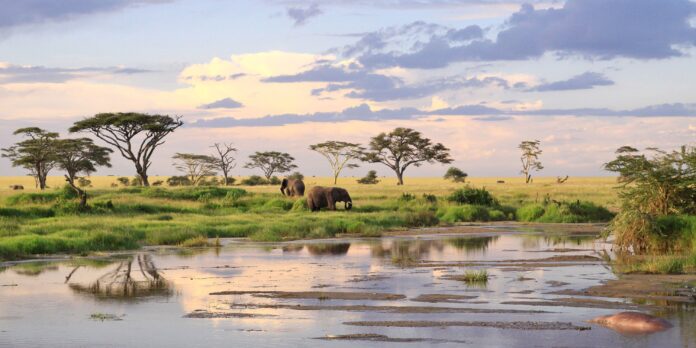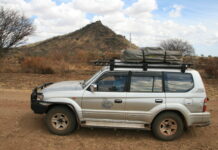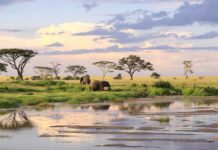The largest un – flooded and un – broken caldera in the world, the Great Wildebeest Migration, and Ngorongoro crater are just a few reasons to visit Tanzania.
Enjoy lunch next to a hippo filled watering hole, spot the legendary tree-climbing lion, and watch as massive tusked elephants amble about the Serengeti on a once in a life time safari in East Africa.
The Tanzania safari tours offers travelers the opportunity to experience first-hand the Maasai culture, amazing animal viewing, and epic ascents up Mount Kilimanjaro, the world’s largest free-standing mountain.
This safari includes the Serengeti, Lake Manyara, Lake Natron, and the Ngorongoro Crater. From the incredible game of an Africa Safari, to the unique tribal villages in the cradle of all mankind, Tanzania offers something for everyone!
Visit a local Maasai community and learn about traditional tribal customs. Hike in Mount Kilimanjaro National Park to spot the elusive tree climbing lion, and stay in comfortable mobile safari camps such as Serengeti Halisi and Pakulala Safari Camp.
Meet your safari representative at Kilimanjaro international airport and transfer to the Kilimanjaro Halisi Retreat where you can rest before starting out on your exciting trip in Tanzania.
Transfer to Moshi the next day and get ready to hike Mount Kilimanjaro National Park. Transfer to the Marangu Gate where you will commence your day hike. Walk through the lush rain forest rising 800 meters to Mandara Hut where you stop for a well-deserved picnic lunch. After your respite you will continue on to Maundi Crater before returning to the Marangu Gate and transferring back to Moshi.
Spend the next day on a game drive in the Tarangire National Park. The park is known for its enormous herds of elephants, ancient baobab trees, and having the greatest concentration of wildlife outside the Serengeti.
During the dry season (June-Sept), animals flock from hundreds of miles to drink from the Tarangire River. Arrive at the Tarangire Safari Lodge in time for dinner.
On a new fresh day, continue with the safari through Tarangire National Park before the heat of the day limits the movement of the animals. After lunch head to the Rhotia Valley, this evening enjoys a guided village walk and learn about the local customs and traditions. You are also welcome to visit the Children’s Home, located adjacent to the lodge. The home is funded directly from the profits of the camp, and provides healthy food, clean water, clothing and education to the kids who stay there.
On a fresh day, descend into the Ngorongoro Crater for a six-hour tour. As the world’s largest caldera (nearly 100 square miles), Ngorongoro boasts over 20,000 large animals, including Tanzania’s remaining black rhino. Living along-side the abundance of wildlife you will find 40,000 Maasai pastoralists with their cattle, goats, and sheep. The conservation gives you a rare look into how people harmoniously lived with nature and wildlife in ancient times. You may also opt to visit Oldupai Gorge. This site provides evidence of the earliest signs of mankind, showcasing hominid footprints preserved in volcanic rock that date back 3.6 million years.
Take a game drive en route to Serengeti National Park, a world heritage site, stopping along the way to watch any animals you may encounter. Renowned for its wealth of lions and leopards, the Serengeti is the quintessential safari destination. The Serengeti plays host to more than a million wildebeest, 200,000 zebra, and 300,000 Thomson’s gazelle during the annual migration.
Head back out for a full day of game drives, examining one of the oldest ecosystems on earth on a fresh day. You will find the renowned plains intermingled with wooded hills, massive termite mounds, rocky kopjes, and acacia tree lined rivers. You never know what animals will reveal themselves when you are in the Serengeti.
After bearing their young in February and March, around April the wildebeest herds begin to drift northwest toward the fresher grass of the central Serengeti, drawing with them thousands of zebras and smaller groups of antelope.
Guided by survival instinct, each wildebeest will cover 800 to 1,000km on its individual journey along age-old migration routes. Hungry predators including lion, leopard, cheetah, hyena, wild dog and crocs make sure only the strongest survive in this natural spectacle also known as ‘the greatest show on Earth.’
The circuit takes the animals from the Ngorongoro Conservation Area (although not into the Crater itself) in the south of the Serengeti in Tanzania, up through the Serengeti and across into the Masai Mara in Kenya and back again. The journey is beset with danger: young calves are snatched by predators; the slow are brought down by prides of lion, brave beasts break legs on steep river slopes, crocodiles take their share of the stragglers, and the weak and exhausted drown.
Visit Lake Natron a surreal soda lake below the Rift Valley escarpment and millions of flamingo’s flocks here, as it is their only breeding ground. Enjoy the views of Ol Dointo L’Engai, the only active carbonite Volcano in the world before heading to Lake Natron Halisi Camp for dinner.
As the fresh water evaporates in the lake, water with high concentrations of salt minerals such as sodium and trona remains. The alkalinity of the lake can reach a pH level of more than 12. Special bacteria and blue algae thrive in this environment and form an ideal breeding ground for the life of birds. Such halophilic organisms include some cyano bacteria that, like plants, produce their own food through photosynthesis. The red pigment in those cyano bacteria produces the deep red colors of the lake’s waters and the orange colors in the shallow areas. Salt-loving microorganisms living there are colouring the alkali salt crust on the surface of the lake is red or pink.
Flamingos find a safe breeding ground at Lake Natron, since most other animals find its caustic environment and high temperature of the lake (up to 60°C) as well as its high salinity inhospitable. It therefore provides a good barrier against predators trying to reach nests on seasonal evaporation islands. Every year, more than two million flamingos come here to lay their eggs and chicks hatch between September and April.
Lake Natron is also home to some endemic algae, invertebrates and other birds. Tens of thousands of other birds can be spotted near the lake, making Lake Natron a prime destination for bird lovers in Africa.


